FAQs
No. DeKalb County Fire Rescue is responsible for fire service and providing ambulance service for Brookhaven.
Applications and plan submittals for land disturbance permits and minor site permits can be submitted on the City Project Portal. After these documents are submitted for review (please ensure the submit button is chosen on the Project Portal) they will be logged for review and sent to the staff members that need to review them. Staff will have review comments ready as quickly as possible, usually within 10 business days for LDPs or 5 days for minor site permits.
Staff members from the Community Development Department are available for appointments and for phone discussions. Meetings with staff should be scheduled in advance. If changes are made throughout the process, those who have signed off previously are required to re-review and sign off on the site plan again. When all comments have been addressed, the permit will be issued. Prior to permit issuance, the City Engineer will verify that all plans and documents for the permit have been executed and are approved. This usually occurs within 48-hours after the final sign-off. To obtain a copy of these documents and procedures, please call City Hall at 404-637-0500.
Yes, all trees 4" in DBH or larger require a tree removal permit. The application is subject to arborist approval. You must submit an application via the Project Portal with photos of the tree, a site plan, and Tree RemovalApplication (click here for packet).
Any activity that involves land disturbance under 5000 sq. ft in the form of new impervious surfaces, replacement, repair or reconfiguration of an impervious surface, alternate surface installation, grading, landscaping, construction or repair of a retaining wall under 4.0 feet, or drainage improvements requires a Minor Site Permit. To find out more information regarding the requirements of a Minor Site Permit, please visit the Minor Site Work Permit Reference Guide.
Runoff reduction practices are stormwater Best Management Practices (BMPs) used to disconnect impervious and disturbed pervious surfaces from the storm drainage system. The purpose is to reduce post-construction stormwater runoff rates, volumes, and pollutant loads. Runoff reduction is more than simple infiltration. The Runoff Reduction Volume (RRV) is the retention volume calculated to infiltrate, evapotranspirate, harvest and use, or otherwise remove runoff from a post-developed condition to more closely mimic the natural hydrologic conditions.
Certain conditions, such as soils with very low infiltration rates, high groundwater, or shallow bedrock, may lead a local jurisdiction to waive or reduce the runoff reduction requirement for proposed site development on a case-by-case basis. If any of the stormwater runoff volume generated by the first 1.0” of rainfall cannot be reduced or retained on the site, due to site characteristics or constraints, the remaining volume shall be increased by a multiplier of 1.2 and shall be intercepted and treated in one or more best management practices that provide at least an 80 percent reduction in total suspended solids.
The Policy on Practicability Analysis for Runoff Reduction (practicability policy) was developed to provide guidance about the site conditions and supporting documentation that could justify a “Determination of Infeasibility” for the runoff reduction requirement. This practicability policy does not address infeasibility for linear transportation projects being constructed by the local jurisdiction, other local governments, or authorities.
The practicability policy is based on the following principles:
It is designed to help administrators implement a process for granting a Determination of Infeasibility that supports efficient review of land development applications.
It applies to new development and redevelopment projects for public and private post-construction stormwater BMPs. It is referenced in the Model Ordinance for Post-Construction Stormwater Management for New Development and Redevelopment (Model Ordinance) developed by the Metropolitan North Georgia Water Planning District (Metro Water District).
It aligns with requirements for runoff reduction in the Georgia Environmental Protection Division’s (EPD’s) permit to discharge from the municipal separate storm sewer system (MS4) permit. The MS4 permit states that the stormwater management system shall be designed to retain the first 1.0 inch of rainfall on the site to the maximum extent practicable. Most Georgia Stormwater Management Manual (GSMM) BMPs include a runoff reduction component.
It is focused on the typical site conditions and regulatory environment in the Metro Water District and may not be applicable for all of Georgia.
It requires a pre-submittal meeting when pursuing a Determination of Infeasibility to ensure all attempts to provide 100% RRv on site have been exhausted.
The local jurisdiction is responsible for the review of land development applications and determination that it is infeasible to apply the runoff reduction requirement on part or all of a proposed site development. Local jurisdictions may choose to make substantive changes or otherwise customize this practicability policy. These further changes and customizations are allowable so long as their substance meets the requirements of a local jurisdiction’s MS4 permit. EPD is responsible for evaluating MS4 permit and District Plan compliance, which includes verifying whether changes and customizations are “at least as effective.” EPD has reviewed this document and their comments have been incorporated.
Conditions that may warrant a Determination of Infeasibility
The GSMM provides broad guidance about conditions that may lead a local jurisdiction to waive or reduce the runoff reduction requirement. The following conditions may warrant a Determination of Infeasibility.
- Soil Infiltration Rate: The soil infiltration rate is less than 0.5 inch per hour as measured over a meaningful portion of the site. Consideration should be given to infiltration rates throughout the soil profile.
- Water Table: The seasonal high-water table is less than two feet from the bottom of an infiltration practice.
- Shallow Bedrock: Material that cannot be excavated except by drilling or blasting AND is less than two feet from the bottom of an infiltration practice.
- Extreme Topography: In the proposed final condition, as shown on the Stormwater Concept Plan with the proposed post-development condition, anything steeper than 3:1 slope for more than 50% of the site.
- Karst Topography: Any of the existing condition is karst.
- Hotspots/ Contamination: Reasonable suspicion that previous uses of the site have resulted in soil contamination.
- Historic Resources: Buildings, structures, or historic sites included in the Georgia Historic Preservation Division’s Historic Resources Survey or listed in the National Register of Historic Places or that has been recommended as a historic resource by a Preservation Professional.
- Site Constraints: Sites where the density or nature of the proposed redevelopment would create irreconcilable conflicts for compliance between the on-site runoff reduction requirement and other requirements such as zoning, floodplains, stream buffers, or septic fields.
- Economic Hardship: The cost of retaining the first 1.0 inch of rainfall onsite using runoff reduction practices is a minimum of three times greater than the cost of providing water quality practices. This condition must be present with another site condition for a Determination of Infeasibility. Additionally, a Determination of Infeasibility for economic hardship may only be allowed for up to 50% runoff reduction volume.
Overview of Processing a Determination of Infeasibility
Obtaining a Determination of Infeasibility
Determination of Infeasibility is not an all or nothing proposition. Designers must demonstrate that they have explored all avenues to meet the runoff reduction standard. If this is determined to be infeasible, they must attempt to provide the maximum percentage of RRv on site as feasible. Only after all attempts to provide any RRv on site are exhausted will the local jurisdiction consider a Determination of Infeasibility. The following process is recommended to:
- identify conditions early,
- provide flexibility,
- support efficient land development application review, and
- protect water quality to the maximum extent practicable.
Does the Site Qualify for a Determination of Infeasibility?
Answering “NO” to any of the following questions may indicate that the site qualifies for a Determination of Infeasibility:
- Can GSMM runoff reduction BMPs fully meet the runoff reduction volume?
- Does the site analysis show the conditions are supportive for managing the calculated runoff reduction volume needed for the site?
- Can better site design practices (see GSMM, Volume 2, Section 2.3) be used to avoid challenging site conditions or constraints?
- Can BMPs, such as green roofs and rainwater harvesting techniques, be used in ways that do not require infiltration into subsurface soils, but rather rely on evapotranspiration and reuse?
- Can the installation of multiple runoff reduction BMPs, such as installing runoff reduction BMPs at higher elevations or in multiple sub watersheds, manage the calculated runoff reduction volume needed for the site?
Prior to Construction
- The design professional identifies conditions that limit using runoff reduction methods to retain 100% of the first 1.0 inch of rainfall onsite and initiates a pre-submittal meeting with the plan reviewer prior to submittal of the land development permit application. During the meeting, the following information will be reviewed:
- Runoff Reduction Infeasibility Form to initiate the request and provide basic project information, confirmation that supporting documentation was submitted, and documentation of pre-submittal meeting outcomes.
- Stormwater Concept Plan that has been developed based on site analysis, and natural resources inventory (including impracticability) in accordance with Section 2.4.2.5 of the GSMM.
2. The plan reviewer will evaluate the pre-submittal information on a case-by-case basis; coordinate with the design professional to understand site-specific issues; and (if possible) explore potential design strategies to achieve 100% RRv in compliance with the standards and specifications of the Post-Construction Stormwater Management Ordinance and GSMM.
3. Based on the pre-submittal information and meeting, the plan reviewer will provide one of the following determinations to the design professional:
- Approval – preliminary Determination of Infeasibility issued
- Approval with conditions – preliminary Determination of Infeasibility issued with conditions to incorporate plan reviewer comments into the Stormwater Concept Plan
- Denial - revise the Stormwater Concept Plan to obtain 100% RRv
4. Design professional may either:
- Submit the land development application with the Stormwater Management Plan and preliminary Determination of Infeasibility (as applicable).
- Appeal the “denial” or “conditions” following the appeals process outlined in the local jurisdiction’s regulations.
During Construction
- During the development process, the owner encounters a site condition that would prevent building stormwater BMPs as specified in the Stormwater Management Plan. The design professional will complete a Runoff Reduction Infeasibility Form and initiate a meeting with the local jurisdiction plan reviewer to discuss the findings. The designer must evaluate modifications to the proposed BMPs or installation of alternative BMPs that will provide some or all RRv in an alternative method.
- The plan reviewer will evaluate the Runoff Reduction Infeasibility Form on a case-by-case basis; coordinate with the design professional to understand site-specific issues; and (if possible) explore potential design strategies to keep the stormwater BMPs identified in the Stormwater Management Plan.
- Based on the Runoff Reduction Infeasibility Form and meeting, the plan reviewer will provide one of the following determinations to the design professional:
- Approval – Determination of Infeasibility is issued and attached to the land development permit
- Approval with conditions – preliminary Determination of Infeasibility issued with conditions to either:
- Revise the design of runoff reduction methods (e.g. adding soil amendments or an underdrain to maximize runoff reduction volume) to retain the first 1.0 inch of rainfall onsite.
- Meet the stormwater runoff quality/reduction standard through a combination of Runoff Reduction and Water Quality
4. Design professional may either:
- Continue construction as outlined modified Stormwater Management Plan under the Permit Revision with approved Determination of Infeasibility.
- Appeal the “conditions” following the appeals process as outlined in the local jurisdiction regulations.
Any activity that involves the moving of large quantities of dirt (within an area of 5,000 SF or more) or a drainage modification on a site that is not being developed for a single family residential building will require a Land Disturbance Permit. There are instances when a Land Disturbance Permit (LDP) may be required for the building of a home. To determine whether an LDP is required for the activity you are planning, please contact City Hall at 404-637-0500.
A permit shall be obtained before beginning construction, erection, alteration or repair to a building or structure, mechanical system, gas system, plumbing system, electrical system, and energy conservation system, other than ordinary repairs. Permits shall be obtained before beginning work. Permits for emergency work shall be obtained within 24 hours after work is commenced. Refer to Sec. 7-118 of the Code of Ordinances for exemptions. Building permit requirements are found in in the Code under Chapter 7 Buildings and Construction.
Since 2014, the City has received nine distinct annexation applications. These were 100% citizen initiated with no City support, encouragement, or involvement. Seven of these annexations were approved (see map below) and two were withdrawn. Additionally, the City regularly receives inquiries from residents and businesses to annex into Brookhaven. These uncoordinated annexation applications result in disjointed service delivery for both the City and the DeKalb County.
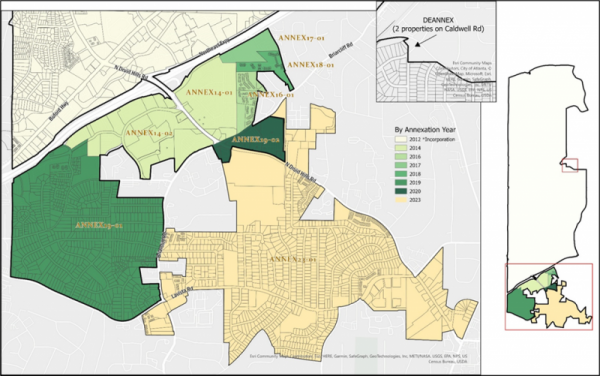
The City of Brookhaven’s goal is to develop a logical service area for both the City and DeKalb County and assist communities in reaching that goal. See the map below.
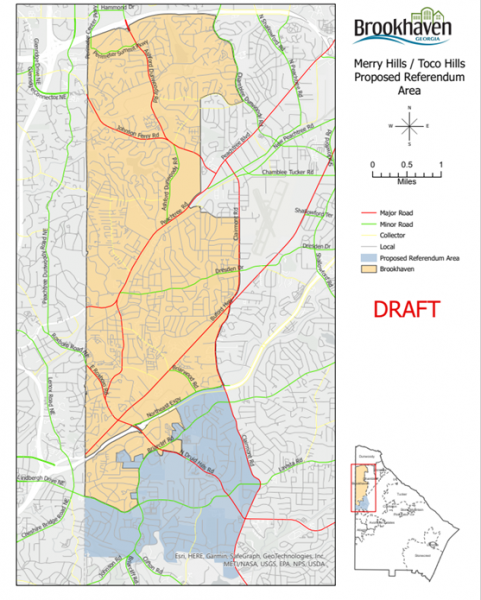
The cities within DeKalb County have sought since 2017 to engage DeKalb County to consider full municipalization of DeKalb County (similar to Fulton County) to avoid the constant churn of annexation requests and new city initiatives.
Brookhaven enforces State-mandated construction and fire codes, City of Brookhaven Codes, and some Federal requirements, such as accessibility. For questions about codes, please contact the Building Official or Building Plan Reviewer.
The annexation process is set by the state and creates a situation where up to 40% registered voters and the owners up to 40% of the annexation geographic area have no say in the approval of annexation. Additionally, the City’s goal is to create a service area reflected in the following map. This could be achieved in one referendum or through multiple annexation applications. A single referendum is more inclusive and efficient.

Parcels are selected based on the State of Georgia requirement of at least 60% of the owners of the land area and at least 60% of registered voters. Annexation application scenarios are developed within these requirements that best avoid islands and encourage logical service delivery boundaries. It is anticipated that 5-7 annexation applications will be necessary to complete the service area goal. See map below.
The City of Brookhaven has asked DeKalb County to place a referendum on the fall 2023 ballot to allow every registered voter to participate in the decision process.

It is anticipated that 5-7 annexation applications will be needed to complete the service area goal. See map below. A signed petition is valid for one calendar year. If you signed a petition, as either a property owner and / or registered voter, you will be included in a future annexation application.
The City of Brookhaven has asked DeKalb County to place a referendum on the fall 2023 ballot to allow every registered voter in the proposed annexation area to participate in the decision process.

After allowing 10 business days for review, if you have not received review comments or approval, please contact a permit tech to check the status of your application.
State law requires signed petitions representing at least 60% of the owners of the land area and at least 60% of the registered voters in an annexation application area. While 100% is ideal, it is not required in the state prescribed process, and not practical as the service delivery area would be inefficient.
The City of Brookhaven has asked DeKalb County to place a referendum on the fall 2023 ballot to allow every registered voter in the proposed annexation area to participate in the decision process.

Generally, yes. The City enforces Georgia state contractor licensing laws. Contractors must provide their state licenses to pull permits. There are exceptions, such as when a homeowner performs work on their own home and provides a notarized Homeowner Affidavit, or for limited specialty trades.
Mayor John Ernst contacted DeKalb County CEO Michael Thurmond on multiple occasions prior submission of the annexation application.
The DeKalb County CEO’s comments of never being contacted at the June 27, 2023 community meeting are not accurate. Additionally, the City’s support of community annexation efforts has been widely reported in the media. County Commission offices were also contacted prior to the submission of the annexation application.
DeKalb cities have attempted to engage DeKalb County for years on the municipalization of the entire County to avoid the creation of new cities and encroachment from the City of Atlanta. These efforts were never taken seriously with the County’s response to “study” and conclude it would cost the County millions in tax revenue. Governments “lose” revenue in economic downturns and work it out through service reductions, and or tax rate increase. In the case of annexation, services are transferred to the City of Brookhaven and provided at the lower cost…resulting in a tax break to residents and business.
Since 2000, there have been over 100 annexations in DeKalb County.
Permit fees, including minimum fees and review fees, are listed in the City’s Fee Schedule. Valuation is calculated using the most recent version of the ICC Data Valuation table.
Georgia law requires at least 60% of registered voters in an annexation application. Unfortunately, due to DeKalb County’s outdated voter lists, apartment complexes have many times the number of voters than actual units. When residents relocate, especially out of the area, they typically do not proactively notify the Board of Elections. As such, it is not uncommon for a single address within an apartment complex to have multiple “registered voters” that do not actually reside at the address.
The City of Brookhaven has asked DeKalb County to place a referendum on the fall 2023 ballot to allow every registered voter to participate in the decision process.

The inspections required vary by type of permit and scope of work. Rough and framing and final building inspections are combination inspections, meaning all the trades are inspected at the same time as the building and must be ready concurrently. New construction, including additions, decks, and accessory structures, and demolitions, requires initial and final site inspections by the land development inspector. Commercial construction requires inspections by the City Fire Marshal. Information is provided when permits are issued.
No. DeKalb County has exclusive control of emergency medical services (EMS) response. Brookhaven has sought for several years the authority to provide this essential service directly. The County has blocked these efforts. Brookhaven tracks the performance of DeKalb County’s EMS response quarterly Please see the graphic below.
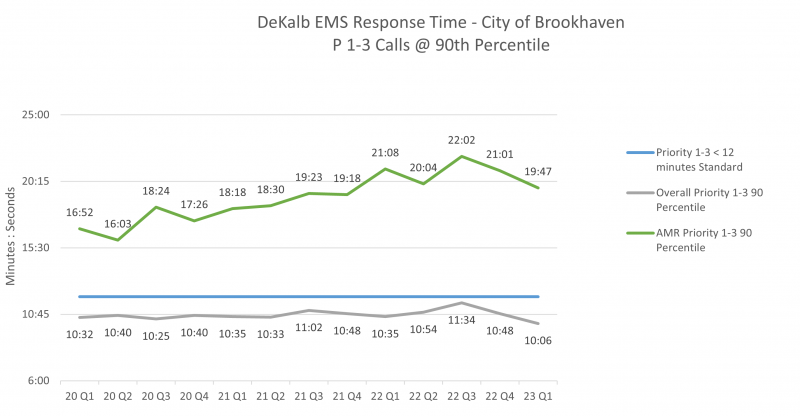
In summary, only 52% of the time DeKalb County EMS response is 12 minutes or less.
NOTE: DeKalb County does not provide any EMS response performance data on its website or in any communications to its residents.
All inspection requests must be submitted through the Project Portal. Requests received before 4 p.m. can be performed the following business day. To cancel an inspection, call 404-637-0500.
Yes. Brookhaven’s goal is police response to priority 1 calls within 6 minutes 80% of the time.
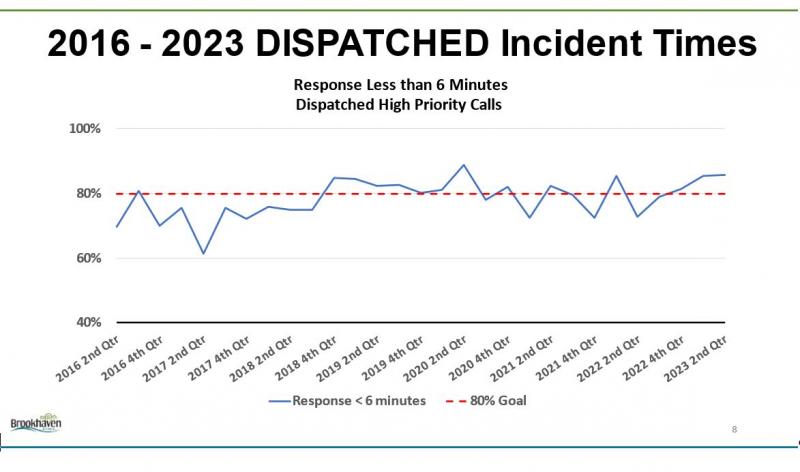
The City’s standard is arrival within 6 minutes on at least 80% of all priority 1 calls. DeKalb County does not provide any police response performance data on its website or in any communication to its residents.
NOTE: DeKalb County has over 100 police officer vacancies; Brookhaven has no vacancies.
If the inspection is not passed after the first re-inspection, re-inspection fees must be paid before the next inspection can be scheduled.
Yes. Brookhaven’s pavement condition index (PCI) is 64 out of a 100-point scale.
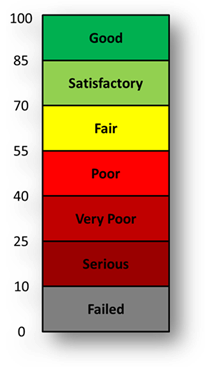 DeKalb County does not include road condition information on its website or to its residents.
DeKalb County does not include road condition information on its website or to its residents.
Based on a limited laser scan of the streets in the annexation area in unincorporated DeKalb County, the County PCI is 53, representing a Poor rating. For reference, when Lavista Park annexed into Brookhaven from unincorporated DeKalb County in 2019, the PCI was 50 (a rating of Poor) in the annexation area. Since then, the City of Brookhaven has improved the LaVista Park roads to a PCI of 60 in 2023.
